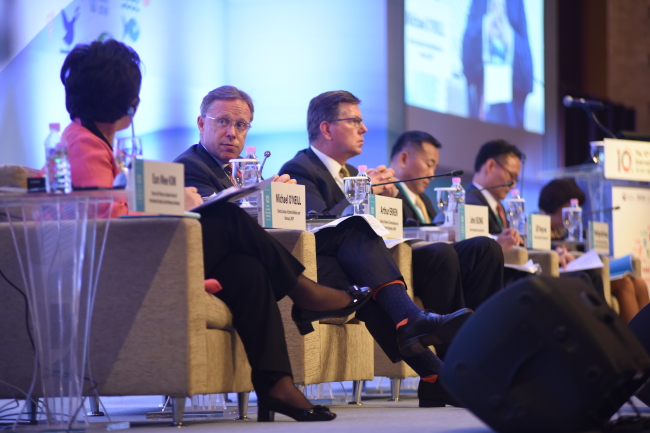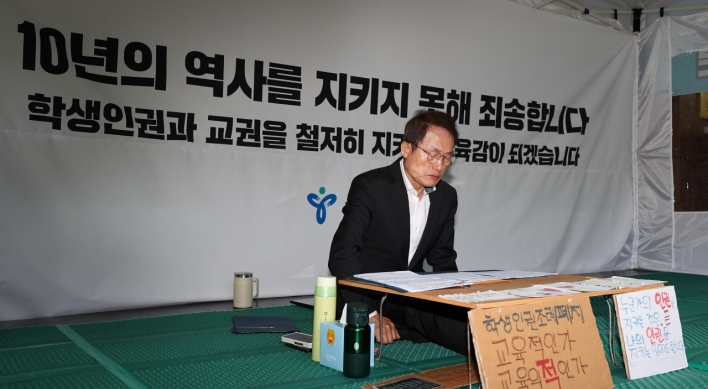‘Tackling inequality, partnerships key to new development era’
By Shin Hyon-heePublished : Aug. 31, 2016 - 17:04
The international community should continue to capitalize on political will and diversify funding sources through partnerships to achieve inclusive growth going forward, experts said Wednesday.
Some 400 policymakers, academics and relief workers from around the world gathered for the Seoul ODA International Conference hosted by the Foreign Ministry and the Korea International Cooperation Agency.
Under the theme “Looking Back and Moving Forward,” the two-day event sought to explore better ways to enforce the Sustainable Development Goals adopted by the United Nations last year as a new global development agenda for the next 15 years, based on lessons from its predecessor, the Millennium Development Goals.
Some 400 policymakers, academics and relief workers from around the world gathered for the Seoul ODA International Conference hosted by the Foreign Ministry and the Korea International Cooperation Agency.
Under the theme “Looking Back and Moving Forward,” the two-day event sought to explore better ways to enforce the Sustainable Development Goals adopted by the United Nations last year as a new global development agenda for the next 15 years, based on lessons from its predecessor, the Millennium Development Goals.

“We shall reflect how the previous era of MDGs led positive behavioral change to global citizens and managed to immensely upgrade donor and partner countries’ development policies,” KOICA President Kim In-shik said in his welcoming remarks.
The participants praised the MDGs’ role in consolidating member states’ commitments and mobilizing financial resources, as well as shifting the mainstay of the international aid discourse from economic growth toward people-centered social development.
However, they also highlighted the uneven progress among targets and countries, and persistent challenges such as growing inequality, climate change and humanitarian disasters.
“When we look back, despite progress that we’ve made, we also know that significant gaps remain; in particular inequality remains an enormous challenge,” said Michael O’Neill, a UN assistant secretary-general and director for external relations and advocacy at the UN Development Program.
The SDGs represent a “more interconnected, ambitious and demanding agenda,” he said, stressing the need to actively employ the Addis Ababa action agenda to funnel more resources into the poorest, least-developed nations.
Forged last year in the Ethiopian capital, the measure calls for broadening revenue bases, more effective tax collections and preventing corruption to expedite financial flows to improve global finance practices and generate investments in development cooperation.
Korea’s Vice Foreign Minister Cho Tae-yul echoed O’Neill’s point, emphasizing the significance of boosting support for fragile states and vulnerable groups in fostering inclusive growth.
About two-thirds of the states, home to 43 percent of the world population living in extreme poverty, failed to meet the poverty reduction target within the MDGs, he noted.
Cho introduced the “Better Life for Girls” initiative, under which Seoul earmarked $200 million for the next five years to facilitate education and health care for young women in underdeveloped regions.
“In many developing countries including fragile states, vulnerable groups, particularly women, girls, the disabled and ethnic minorities, face a higher risk of poverty and social exclusion,” he said in his congratulatory address.
“We believe that providing quality education for girls in developing countries is the best investment for securing a sustainable future.”
Arthur Erken, director for communications and strategic partnerships at the UN Population Fund, said that compared to the MDGs, the SDGs have “far more international ownership” and feature greater importance of partnerships not only between governments but also within civil society, academia and the private sector.
The girls initiative, he noted, would bring the investments necessary to “tap the potential” of youth in regions like Africa by offering opportunities.
“It’s important to picture (the future) through the eyes of a 10-year-old girl today who will be 25 years old by the time the SDGs are supposedly finished,” he said during the session.
“That is the face of the SDGs. If we succeed, putting all pieces together, she and her brothers and sisters could have a sustainable future, better life and better world.”
By Shin Hyon-hee(heeshin@heraldcorp.com)
The participants praised the MDGs’ role in consolidating member states’ commitments and mobilizing financial resources, as well as shifting the mainstay of the international aid discourse from economic growth toward people-centered social development.
However, they also highlighted the uneven progress among targets and countries, and persistent challenges such as growing inequality, climate change and humanitarian disasters.
“When we look back, despite progress that we’ve made, we also know that significant gaps remain; in particular inequality remains an enormous challenge,” said Michael O’Neill, a UN assistant secretary-general and director for external relations and advocacy at the UN Development Program.
The SDGs represent a “more interconnected, ambitious and demanding agenda,” he said, stressing the need to actively employ the Addis Ababa action agenda to funnel more resources into the poorest, least-developed nations.
Forged last year in the Ethiopian capital, the measure calls for broadening revenue bases, more effective tax collections and preventing corruption to expedite financial flows to improve global finance practices and generate investments in development cooperation.
Korea’s Vice Foreign Minister Cho Tae-yul echoed O’Neill’s point, emphasizing the significance of boosting support for fragile states and vulnerable groups in fostering inclusive growth.
About two-thirds of the states, home to 43 percent of the world population living in extreme poverty, failed to meet the poverty reduction target within the MDGs, he noted.
Cho introduced the “Better Life for Girls” initiative, under which Seoul earmarked $200 million for the next five years to facilitate education and health care for young women in underdeveloped regions.
“In many developing countries including fragile states, vulnerable groups, particularly women, girls, the disabled and ethnic minorities, face a higher risk of poverty and social exclusion,” he said in his congratulatory address.
“We believe that providing quality education for girls in developing countries is the best investment for securing a sustainable future.”
Arthur Erken, director for communications and strategic partnerships at the UN Population Fund, said that compared to the MDGs, the SDGs have “far more international ownership” and feature greater importance of partnerships not only between governments but also within civil society, academia and the private sector.
The girls initiative, he noted, would bring the investments necessary to “tap the potential” of youth in regions like Africa by offering opportunities.
“It’s important to picture (the future) through the eyes of a 10-year-old girl today who will be 25 years old by the time the SDGs are supposedly finished,” he said during the session.
“That is the face of the SDGs. If we succeed, putting all pieces together, she and her brothers and sisters could have a sustainable future, better life and better world.”
By Shin Hyon-hee(heeshin@heraldcorp.com)





![[KH Explains] No more 'Michael' at Kakao Games](http://res.heraldm.com/phpwas/restmb_idxmake.php?idx=644&simg=/content/image/2024/04/28/20240428050183_0.jpg&u=20240428180321)












![[Herald Interview] Mistakes turn into blessings in street performance, director says](http://res.heraldm.com/phpwas/restmb_idxmake.php?idx=652&simg=/content/image/2024/04/28/20240428050150_0.jpg&u=20240428174656)
